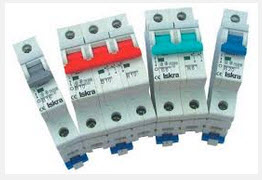At an exchange, one or several circuit breakers for the trading can be installed to halt all trading when certain conditions are fulfilled. Circuit breakers are typically installed to halt trading when a significant decrease in value has occurred. This idea is to prevent a panic situation where large sell-offs triggers even larger sell-offs and the value is sucked into a downward spiral. Since a circuit breaker is a form of restraint on the traders, it is also known as a collar.
 At the time of writing, the New York Stock Exchange (NYSE) has three circuit breakers installed, and they are all based on the average closing price of the S&P 500. At the start of each new quarter, the circuit breakers are calibrated using the previous month’s average S&P 500 closing price.
At the time of writing, the New York Stock Exchange (NYSE) has three circuit breakers installed, and they are all based on the average closing price of the S&P 500. At the start of each new quarter, the circuit breakers are calibrated using the previous month’s average S&P 500 closing price.
- If the first circuit breaker is triggered, all trade on NYSE will be automatically halted for 15 minutes. (Unless it’s after 3:25 p.m. local time, because then NYSE is closed until the next trading day.)
- If the second circuit breaker is triggered, all trade on NYSE will be automatically halted for 15 minutes. (Unless it’s after 3:25 p.m. local time, because then NYSE is closed until the next trading day.)
- If the third circuit breaker is triggered, NYSE is closed until the next trading day.
Having circuit breakers installed on exchanges have become increasingly important during recent years due to the proliferation of pre-set sell orders that will close positions automatically if the market price drops below a certain level.
So far, all circuit breakers installed by exchanges are triggered by price falls – not by price raises. This can be seen as an example of institutionalized bubble bias. The exchange sees no reason to curb trading during periods of rapid price raises, even though these situations can be just as “panicky” as situations where the price is falling quickly.
This article was last updated on: January 18, 2016